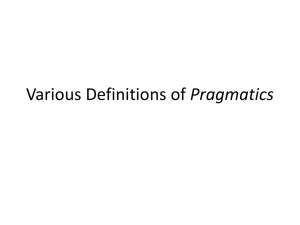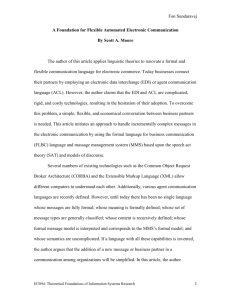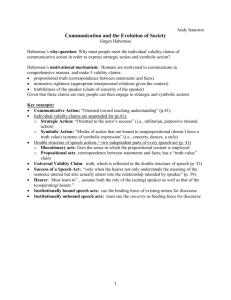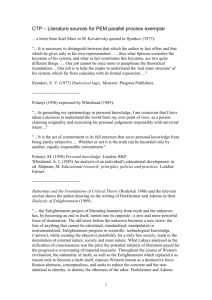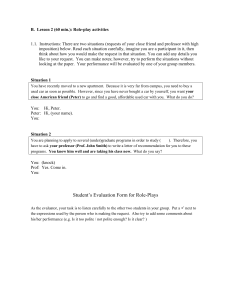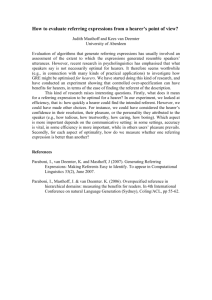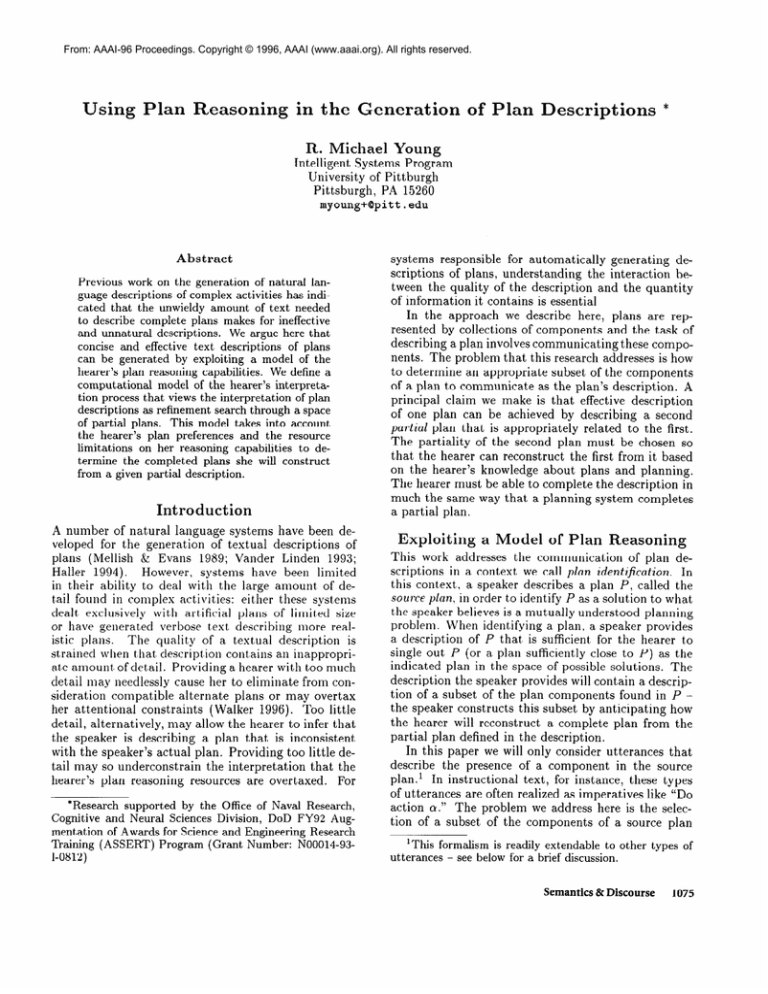
From: AAAI-96 Proceedings. Copyright © 1996, AAAI (www.aaai.org). All rights reserved.
Using
Plan Reasoning
in the Generation
R. Michael
of Plan Descriptions
*
Young
Intelligent
Systems Program
University of Pittburgh
Pittsburgh,
PA 15260
myoung+@pitt.edu
Abstract
Previous work on the generation
of natural language descriptions
of complex activities has indicated that the unwieldy amount of text needed
to describe complete
plans makes for ineffective
and unnatural descriptions.
We argue here that
concise and effective text descriptions
of plans
can be generated
by exploiting
a model of the
hearer’s plan reasoning capabilities.
We define a
computational
model of the hearer’s interpretation process that views the interpretation
of plan
descriptions
as refinement search through a space
of partial plans.
This model takes into account
the hearer’s plan preferences
and the resource
limitations
on her reasoning
capabilities
to determine the completed
plans she will construct
from a given partial description.
Introduction
A number of natural language systems have been developed for the generation
of textual descriptions
of
plans (Mellish QL Evans 1989; Vander Linden 1993;
Hailer 1994).
However, systems have been limited
in their ability to deal wit811the large amount of debail found in complex act,ivit,ies: eit,her these systems
dealt, exclusively
with artificial plans of limited size
or have generat,ed verbose text describing
more realThe qualit,y of a t,extual description
is
istic plans.
strained when that, clescript,ion contrains an inappropriabe a.mount8 of detail. Providing a hearer with too much
detail may needlessly cause her to eliminate from consideration
compatNible alternate
plans or may overtax
her attNentional constraints
(Walker 1996). Too little
detail, alternatively,
may allow the hearer to infer that
the speaker is describing
a plan that is inconsistent
with the speaker’s actual plan. Providing too little detail may so underconstrain
the interpretation
that the
hearer’s plan reasoning
resources are overtaxed.
For
*Research
supported
by the Office of Naval Research,
Cognitive
and Neural Sciences Division,
DOD FY92 Augmentation of Awards for Science and Engineering Research
Training (ASSERT)
P ro g ram (Grant Number:
NO001493I-0812)
systems responsible
for automatically
generating
descriptions of plans, understanding
the interaction
between the quality of the description
and the quantity
of information
it contains is essential
In the approach we describe here, plans are represented by collections of components
and the task of
describing a plan involves communicating
these components. The problem that this research addresses is how
to determine an appropriate
subset of the components
of a plan to communicate
as the plan’s description.
A
principal claim we make is that effective description
of one plan can be achieved by describing
a second
partial plan that is appropriately
related to the first.
The partiality
of the second plan must be chosen so
that the hearer can reconstruct
the first from it based
on the hearer’s knowledge about plans and planning.
The hearer must be able to complete the description
in
much the same way that a planning system completes
a partial plan.
Exploiting
a Model
of Plan Reasoning
This work addresses the communication
of plan descriptions
in a context we call plan identification.
In
this context, a speaker describes a plan P, called the
soul’ce plan, in order t)o identify P as a solution to what
the speaker believes is a mutually underst(ood planning
problem. When identifying a plan, a speaker provides
a description
of P that’ is sufficient, for the hearer to
single out P (or a plan sufficiently close to P) as the
indicated plan in the space of possible solutions.
The
description
the speaker provides will contain a description of a subset of the plan components
found in P the speaker constructs
this subset by anticipating
how
the hearer will reconstruct
a complete plan from the
partial plan defined in the description.
In this paper we will only consider utterances
that
describe the presence of a component
in the source
plan.’ In instructional
text, for instance, these types
of utterances
are often realized as imperatives
like “Do
action Q .” The problem we address here is the selection of a subset of the components
of a source plan
‘This formalism is readily extendable
to other
utterances - see below for a brief discussion.
types
Semantics & Discourse
of
1075
P sufficient to identify P to the hearer.
In our approach, a speaker uses the model of the hearer’s plan
reasoning capabilities
to select a subset with greater
or fewer components
depending
on (at least) two factors. First, the hearer’s plan reasoning resources may
limit her ability to find completions;
the constraints
in
a description
may be so sparse that finding the completions of the constraints
is too great a task for the
hearer.
Candidate
subsets that overtax the hearer’s
abilities can be eliminated
from consideration.
The second factor determining
the content of a description
is the amount of variance the speaker can
t,olerate between the plan he is describing and the plan
t#he hearer subsequently
will form. In general, there
may be a number of plans closely related to a source
plan which the speaker would be happy for the hearer
to identify. The degree to which these closely related
plans vary from the actual source plan is dependent
upon the measure of cacceptability that the speaker uses.
In the limiting case, acceptability
corresponds
to identity, although for many domains acceptability
may be
a much weaker notion. Given the hearer’s plan preferences, the particular
constraints
in a description
may
guide him to solutions
that are unacceptable
to the
speaker. Subsets that define planning problems where
unacceptable
plans are likely to be selected can also be
eliminated.
We will use a representation
of the planning process
1993).
referred to as plan-space search (Kambhampati
Plan-space
search provides a flexible representation
of
partial plans and the types of planning operations hearers may perform when interpreting
a partial plan description.
In addition, plan-space
search characterizes
the planning activity of a wide class of current planning
systems - developing a text generation system built on
plan-space
search allows us to apply these techniques
to any plan representation
that can be characterized
in
this way. In plan-space search, each node in the search
space is defined by a partial plan and denotes a set of
plans; this set, called the node’s candidate set, corresponds to the class of all legal completions
of the part’ial plan at that node. Search through the plan space is
performed by refining the partial plan at a given node.
R.efinements correspond
to one of a well-specified set of
plan-const,ruction
operations
(e.g., adding a new step
to e&ablish an open precondition).
Each refinement
of a parent node creates a child node whose candidate
set is a subset of the parent’s.
The plan space forms
a graph whose single root node is an empty plan and
whose leaf nodes are either inconsistent
plans or solutions to the planning problem.
In refinement
search, an evaluation
function is used
to characterize
the candidate
set of each node encountered in the search, mapping the node to one of three
values.
When a node evaluates to FAIL, there is no
plan in the node’s candidate
set that solves the planning problem. Consequently,
the node must be pruned
from the search space and the search algorithm
must
1076
Natural Language
backtrack.
When a node evaluates to a complete plan
contained
in the candidate
set, that plan solves the
planning problem and the search algorithm can return
this plan. When a node evaluates to I, the evaluation
function cannot determine if a solution is contained in
the candidate set and further refinement is needed.
In this paper, we will use a partial-order,
causal
link planner called DPOCL (Young, Pollack, & Moore
1994). This planner extends the UCPOP planner (Penberthy & Weld 1991) by incorporating
a hierarchical
plan representation.
Use of this representation
mirrors the hierarchical, incremental
development
of plans
indicated in the manner that people tallc about planning (Dixon 1987). Because DPOCL is not a system
built especially for the generation
of task descriptions
(i.e., it is a domain-independent
planning algorithm),
DPOCL plans contain sufficient structure
to ensure
their executability.
Consequently,
they serve as strong
test cases for the generation
of plan descriptions.
In
addition,
DPOCL is readily characterized
as a planspace search algorithm.
A Hearer Model Based on Plan
Reasoning
In this section we propose a model to be used for determining an appropriate
description
of a plan - using
this model involves determining
specific inferences to
be drawn by the hearer from any candidate description.
In particular,
our model anticipates
the plan reasoning
that the hearer undertakes
to complete the partial description the speaker provides.
Definitions
The computational
model we use here is made of a
number of components
representing
the planning algorithms and action representations
used by a speaker
when modeling
the domain
of discourse
and the
hearer’s model of the same domain. In our approach,
the speaker has a planning model representing
his own
plan reasoning capabilities and a separate model of the
hearer’s plan reasoning capabilities.
2
A planning problem consists of a complete specification of the problem’s initial state and the goal state
and a complete specification
of the domains’s
action
and decompositions
operators.
Definition 1 (Planning
Problem)
A
planning problem PP is a three-tuple 4 PO, A, A +,
where PO is a plan specifying only the initial state and
the goal state, A is the planning problem’s set of action
operator definitions and A is the set of decomposition
operator definitions.
As described
above, a plan-space
planning
rithm searches a plan space to find a solution
2We will refer to the speaker’s planning
algoto a
model as the
speaker model and the speaker’s model of the hearer’s planning model as the hearer model.
Typical implementations
produce
planning
problem.
a plan graph during this search representing
the portion of the plan space searched to that, point.
Definition 2 (Plan Graph)
A plan graph GA =+
n, a + for some planning
algorithm A is a singlyrooted, strongly connected graph with nodes n and arcs
a. Each node ni E n is a plan defined by algorithm A
and an arc ni + nj appears in a precisely when nj is
a refinement of ni using algorithm A.
During the planning process, the hearer model employs a heuristic evaluation
function to direct search
through the space of plans. This function ranks plans
that appear in the fringe of the current plan graph;
search proceeds by expanding
those fringe nodes that
are ranked most promising.
Definition 3 (Plan Ranking Function)
For any plan p and plan graph GA, GA =+ n,a +
and p E n, a plan ranking function f maps p and GA
into a set of plans such that I) f partitions the plans
in n into a totally ordered set of sets of plans, 2) this
total order has a single minimal element and 3) each
plan in n must be assigned by f into precisely one of
these sets. 3
For ease of reference, we will identify the total ordering on these sets with the non-negative
integers; plans
that are assigned a lower number are more preferred
than plans assigned a higher ranking.
In order to model the resource limits of a hearer
when she is interpreting
a description,
the hearer’s
limitations
will be represented
by a search limit function that accepts as input a plan graph representing
t,he space alrea.dy explored during a plan-space search.
The function returns T if the plan graph exceeds the
hearer’s search limit and returns F if it does not.
Definition 4 (Search Limit Function)
A search limit function d maps a plan graph G onto
the set {T, F}. For any agent a, d,(G) = T precisely
when G exceeds the planning
resource limit for a.
The hearer model’s planning system combines a particular planning algorithm,
a. search limit function and
an evaluation
function.
Definition 5 (Planning System)
A planning
systern PS is a three-tuple -+ A, d, f + where A is a planspace search algorithm, d is a search, limit function and
f is a plan evaluation function.
Finally, a planning
of a plamling problem
model PM is a pair consisting
and a planning system.
Definition 6 (Planning
PM consists of a planning
system PS.
Model)
A planning
model
problem PP and a planning
Complete
tion function
plans assigned the rank 0 by an evaluain a planning model PM are called the
preferred plans in PM.
In this work we will use as
a measure of acceptability
the difference between the
value of the speaker’s evaluation
function
f applied
to a plan and f’s value when applied to the speaker’s
source plan P, We will assume that the speaker has
some value 6 that serves as a measure of the amount
of variance from P that he will tolerate. Let G, be the
plan graph in which P was found by the speaker, and
let Gh be some plan graph constructed
by the hearer
while solving the same planning problem.
The set of
acceptable plans (or simply the acceptance set) for a
given source plan P contains precisely those plans P’
in Gh such that Ifs(P,Gs) - fs(P’,Gh)l
5 S.
Constraints
on the Hearer
Model
There are a number of constraints
that must be placed
on the plans produced by either the speaker or the
hearer model. First, as described earlier, we will use
DPOCL to model the planning algorithm of the hearer.
That is, Ah = DPOCL. Second, the planning
algorithms of both speaker and hearer will be constrained
to produce only complete plans that contain no unnecessary steps. We assume that the definition of the
planning problem in the speaker and hearer models are
identical.
That is, the specification
of the initial and
goal states are the same. Furthermore,
the discussion
here will not deal with any incompatibility
between the
speaker and the hearer models’ representations
of the
operators in our domain. *
Putting
the Hearer Model
to Use
This hearer model is put to use during the selection of
the contents of a plan description.
The constraints
in
this description
create a new planning problem for the
hearer, one in which the empty plan PO is replaced as
the root node by the partial plan characterized
by the
description.
We will refer to this new plan as P, . PV
has the same initial and goal states as PO but has some
amount of plan detail already filled in. As a result, the
characteristics
of the plan space below this node differ
from that of the plan space of the original problem.
By examining
the manner in which this new plan
space will be searched in the hearer model, the speaker
can determine
the efficacy of the corresponding
description.
To be cooperative,
a speaker should select a
set of plan constraints
Pz, such that
e Acceptability:
pletions
of P,
the speaker believes that all comof equal or greater preference to the
41n general, there may be considerable
variance between
the planning model used by the speaker and that assumed
to be used by the hearer. Our approach does not commit
to a particular
policy for reconciling
differences
between
speaker and hearer models but instead allows implementors
to impose policy as their applications
dictate.
Semantics& Discourse
1077
source plan in the hearer model also occur
acceptance set of the speaker, and
in the
Resource
Adequacy:
the speaker believes that at
least one such acceptable
completion
exists in the
plan-space of the hearer model within the bound dh.
When identifying
a plan, the speaker should describe a partial plan whose completions
in the hearer
tnodel are acceptable
with respect to the source plan.
One interpretation
of Grice’s maxim of quantity (Grice
1975) suggests that the speaker must determine a minimal set of constraints
that meet these requirements.
To find a minimal subset of plan constraints
to use as
a description,
the approach defined here uses the planning system of the hearer model to evaluate candidate
descriptions.
To determine
if a collection of plan constraints describe a set of plans that are all acceptable
with respect to the source plan, we can initialize the
hearer model’s planning problem using a subset of the
source plan’s components
and search the space of plans
rooted at that node. To find a description
that obeys
the maxim of quantity,
we begin our search with the
empty subset and increase the size of the initial component set until we reach the first set defining a plan
space where every preferred plan is acceptable.
A Sample
Problem
This section examines three descriptions
for the same
example planning
problem. The planning problem we
will use involves travel from London to Paris. 5 In this
domain, there are three basic ways to travel from London to Paris: by train, by plane and by automobile.
Each option involves the specification
of some further
detail; one can fly to either of the two airports in Paris,
take the train to Paris either by ferrying across the English Channel or traveling directly using the Channel
Tunnel (on the Eurostar) or drive to Paris, again by
taking the ferry across the Channel.
The complete plan space for this planning problem
is shown in figure 1. Each node in this graph represents
a (possibly partial) plan; the graph is rooted at PO, the
null plan that describes only the initial state (being in
London) and the goal state (being in Paris). Each arc
between two nodes in the graph indicates a refinement
of the plan at the first node to form a new plan at the
arc’s second node.
The leaf nodes in this graph are
all solutions to the planning
problem and are labeled
with text giving a rough indication
of their structure.
Each node is also labeled with an integer indicating
the order that the hearer’s plan search function fh will
search the space (described further below).
We will define the hearer model as follows. For illustrative
purposes, we will assume a limited resource
51n these exampl es, we will use a simplified version of
the DPOCL plannerand itsplanrepresentation
tolimitthe
lengthof the discussion.
The techniqueswe presenthere,
however, are applicableto planningproblems of arbitrary
complexity.
1078
NaturalLanguage
1,
<$
Train/
ferry
Figure
Eurostar
1: Complete
FlY to
DeGaulle
n
Initial
(empty)
plan
Fly to
Orly
Plan Space for Travel
Drive/ferry
Problem.
bound on the hearer’s plan reasoning,
bounding
the
search she can perform to graphs with fewer than
5 nodes.
Formally,
for any graph G =4
n, a +,
dh(G) = F precisely when InI < 5.
The speaker’s source plan P is the plan to fly to
Paris by taking a plane from Heathrow to De Gaulle
(numbered
#8 in figure 1). We will assume that the
speaker has two simple but strong factors that effect his
plan preferences:
strong preferences against any plan
that involves train or ferry travel. The speaker’s plan
evaluation
function fs and his measure of variance S
will be set such that the only acceptable plans are those
numbered #8 and #9 in figure 1.
Providing
Too Much
Detail
Consider
the follow-
ing description:
Description
1 To travel to Paris from London,
take the Tube to Heathrow. Next, take a plane
to De Gaulle. Then take a bus from De Gaulle
to Paris. In order to be in London before
taking the Tube, use the effect of starting in
London. In order to be at Heathrow before
taing the plane to Paris,
use the effect of
begin at Heathrow after taking the Tube. In
order to be at De Gaulle before taking a bus to
Paris, use the effect of taking a plane from
Heathrow to De Gaulle. In order to be in Paris,
use the effect of taking a bus from De Gaulle into
Paris.
This description
provides enough detail so that it
specifies exactly one completed plan: the source plan
P that appears as a leaf node (#8) in the original plan
space from figure 1. The new plan space rooted at this
node contains just this single plan.
To evaluate this candidate description,
the speaker
uses the hearer model described above to complete this
plan. Because the plan specified by the description
is
already complete, no search is required; this plan is the
only plan in the set of preferred solutions in the hearer
model. The plan is acceptable,
since it is the source
plan.
By including so much detail in the description,
the
speaker eliminates other acceptable plans - in this case
the plan to fly into Paris’s De Gaulle airport. Moving
the root node of the new plan space farther from the
source plan would make for a more concise description
while including
other acceptable
plans in the hearer
model’s preference set. However, as we show in the
next section, this may also result in the inclusion of
unacceptable
plans in the preference set.
Providing
Insufficient
Detail
Consider
the follow-
ing description:
Description
2 In order to be in Paris, travel
to Paris from London.
This description
describes
a plan containing
only
detail.
the abstract TRAVEL action with no additional
This new plan space is rooted at the node labeled #3 in
figure 1 With a search limit function constraining
the
hearer model’s plan graph t,o contain no more than 5
nodes, the hearer model will only find two solutions
to the planning
problem:
nodes #5 and #S. Both of
these nodes are unacceptable
given the definition offs
described earlier. There are, then, no plans in the preferred set of the hearer model that are also acceptable
to the speaker, making description
2 unacceptable.
Locating
an Appropriate
Description
Effective descriptions
may make reference to any or
all of the components
of a plan. Consequently,
candidate descriptions
lie in the power set of the constraints
present in the speaker’s source plan. The previous examples use descriptions
that lie on either side of an
effective, concise description
for the source plan. One
obvious technique for finding the minimal set of constraints that successfully
describes the plan is to use
a brute force search algorithm:
consider each set in
the power set of the constraints
of the source plan.
This technique
would be initialized
with the initial,
null plan PD and would incrementally
evaluate sets
of constraints,
always considering
the unexamined
sets
with smallest cardinality
next. The algorithm
would
halt with it had either found an acceptable
plan or
exhaust,ed the power set. of plan constraints.
it,‘s possible to locate a set
Using this technique,
of plan constraints
corresponding
to the following description:
Description
3 In order to be in Paris,
travel
to Paris from London. Travel to Paris by
flying.
This description
describes
a plan that
contains
the
TRAVEL step, and a decomposition
for that step involving a FLY action. The plan is partial, since it does not
specify which airport to fly to. This new plan space
is rooted at node labeled #7 in figure 1. The hearer
model will search the plan space below this node and
find two solutions to the planning problem: nodes #8
and #9. Both of these nodes are acceptable
(in fact,
they are the only two), making the description
acceptable. Any other description
of similar or lesser size
would either be rooted at one of node #7’s siblings or
its parents (with spaces that would either lead to unacceptable solutions in the preference set of the hearer
model or that would contain no solutions at all) description 3 is minimal as well.
The technique of selecting minimal descriptions
using exhaustive search corresponds to Dale and Reiter’s
full brevity interpretation
of Grice’s maxims used in
the generation
of referring expressions (Dale & Reiter
1995). This approach has two weaknesses.
First, As
Dale and Reiter point out, the approach is computationally expensive, making it unappealing
for describing complicated
plans or plan spaces. Second, it is not
guaranteed
to isolate a unique description.
For any
given planning problem, there may be a number of acceptable descriptions
all of minimal size. This simple
technique is unable to distinguish
between such competing descriptions.
In these cases, the plan constraints
themselves may
suggest heuristics for choosing between candidate
descriptions.
For instance,
partial plans that are more
referentially
coherent (Long & Golding 1993; Kintsch
1988), that is, whose plan graphs have fewer strong
components,
may be preferred for explanation
over
those that are not. Work in the comprehension
of narrative texts (Long & Golding 1993; Graesser, Lang, &
Roberts 1991; Graesser, Roberston,
& Anderson 1981;
Trabasso
& van den Brock 1985) describes types of
inferences drawn from descriptions
of actions.
It is
possible that these cognitive models can given computational definitions in plan identification.
Related
Work
Several researchers interested in task-related
discourse
have employed
action representations
based on AI
plans.
The principal work on explaining
plans produced by AI planning systems is described by Mellish
and Evans (Mellish & Evans 1989). Their system takes
a plan produced by the NONLIN planner (Tate 1977)
and produces a textual description
of the plan. Their
system generates clauses describing
each component
of the input plan and, as Mellish and Evans point out,
this often results in unnatural
descriptions
containing
too much detail.
Other projects
(Vander Linden 1993; Delin et al.
1994) produce more concise texts describing
activities, but rely on simplified models of plans whose size
and complexity were limited. Dale’s dissertation
(Dale
1992)) focusing on the generation of anaphoric referring
expressions
in text describing cooking plans, avoided
the generation of overly detailed descriptions
by a comSemantics& Discourse
1079
bination of domain-specific
techniques
(e.g., linguistic
information
about the verbs associated
with actions)
and domain-independent
ones (e.g., exploiting
focus
constraints
within the text being produced).
Conclusions
This paper has defined a computational
model of a
hearer’s plan reasoning capabilities that is useful for selecting between competing
candidate
descriptions.
By
viewing the hearer’s interpretation
of a partial description as the task of searching for a completion in a space
of plans, we have been able to provide a formal account
for the requirements
of this task. The requirements
are
described in terms of the hearer’s planning algorithm,
her individual
plan preferences and any resource limits
placed on her planning capabilities.
This model characterizes a number of domain-independent
planning algorithms; as a result, the model can potentially
be used
to generate descriptions
of plans produced from a number of automatic
planning systems.
Future work will address a number of issues. We
will examine t*he use of additional
forms of constraints
in t)ext descriptions
beyond t,hose discussed here (e.g.,
negative imperatives)
and their role in bounding
the
search space that the hearer model must deal with. In
addition, our future work will explore ways to extend
this model to contexts where groups of agents use dialog to coordinate
their plan-related
beliefs. Finally, we
will investigate
techniques
for reconciling
differences
between a speaker’s model of the hearer and the methods actually employed by the hearer during interpretation of a partial plan description.
Acknowledgements
Pollack
Generating
referring
expressions:
descriptions
in a domain of objects and
1992.
Constructing
processes. Cambridge,
Massachusetts:
MIT Press.
Delin, J.; Hartley, A.; Paris, C.; Scott, D.; and Vander Linden, K. 1994. Expressing procedural relationships in multilingual
instructions.
In Proceedings of
the Seventh International
guage Generation,
61-70.
Workshop
on Natural Lan-
Dixon, P. 1987. The structure
of mental plans for
Journal
of Experimental
Psyfollowing directions.
chology:
Learning,
Memory
and Cognition
13118-26.
Elzer, S.; Chu-Carroll,
J.; and Carberry,
S. 1994.
Recognizing
and utilizing user preferences in collaborative consultation
dialogues.
In Proceedings of the
1080
Natural Language
on User Modeling,
Graesser, A.; Lang, K.; and Roberts, R. 1991. Question answering in the context of stories.
Journal of
Psychology:
General
1201254-277.
Graesser, A.; Roberston,
S.; and Anderson,
P. 1981.
Incorporating
inferences in narrative representations:
a study of how and why. Cognitive Psychology 13:126.
Grice, H. P. 1975. Logic and conversation.
In Cole,
P., and Morgan, J. L., eds., Syntax and Semantics III:
Speech Acts. New York, NY: Academic Press. 41-58.
Haller,
S.
Descriptions
Interactive
and Justifications.
of Plan
Ph.D. Dissertation,
of New York at Buffalo.
1994.
State University
Generation
Kambhampati,
S.
1993.
Planning
as refinement
search:
A unified framework for comparative
analysis of search space size and performance.
Technical
Report 93-004, Arizona State University, Department
of Computer Science and Engineering.
Kintsch, W. 1988. The role of knowledge in discourse
comprehension:
a construction-integration
model.
Psychological Review 95:163-182.
Long, D. L., and Golding, J. M. 1993. SuperorAre they automatically
gendinate goal inferences:
Discourse Processes
erated during comprehension?
16:55-73.
Mellish, C., and Evans,
generation
from plans.
15(4).
R.
1989.
Natural
Computational
language
Linguistics
Penberthy,
J. S., and Weld, D. 1991. UCPOP:
sound, complete partial order planner for ADL.
A
In
Proceedings of the Third International
Conference
Knowledge Representation
and Reasoning.
on
project
ceedings of the International
Joint
tificial Intelligence, 888 - 893.
Dale, R., and Reiter, E. 1995. Computational
interpretations
of the Gricean Maxims in the generation
of referring expressions.
Applied Artificial Intelligence
Journal 9. to appear.
R.
Conference
Tate, A. 1977. Generating
References
Dale,
International
19 - 24.
Experimental
and Future Work
The author thanks Johanna
Moore, Martha
and the reviewers for their helpful comments.
Fourth
networks.
In Pro-
Conference
on Ar-
Trabasso, T., and van den Brock, P. 1985.
thinking and the representation
of narrative
Journal
Vander
of Memory
Linden,
and Language
24~612-630.
K. 1993. Speaking of Actions:
ing Rhetorical Status and Grammatical Form
structional Text Generation. Ph.D. Dissertation,
versity of Colorado,
Department
ence.
Walker, M. 1996. The effect of
task complexity on collaborative
Artificial Intelligence.
to appear.
Young, R. M.; Pollack, M. E.; and
Decomposition
and causality
in
ning. In Proceedings of the Second
ference
on AI and Planning
Causal
events.
of Computer
resource
planning
Choosin In-
UniSci-
limits and
in dialog.
Moore, J. D. 1994.
partial order plan-
International
Systems, 188-193.
Con-

